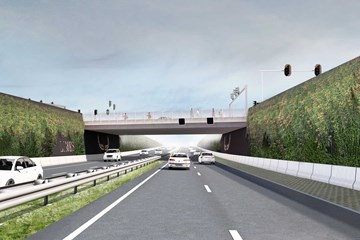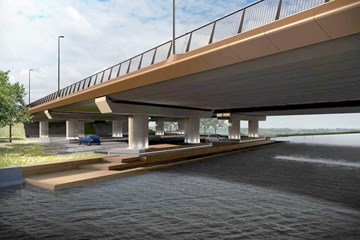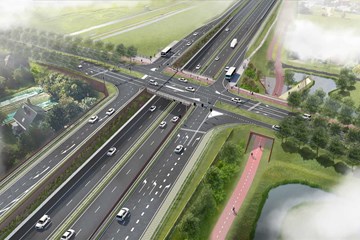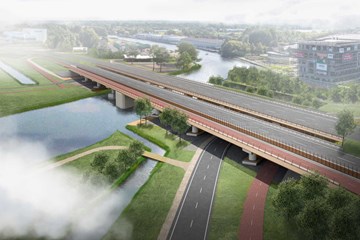N206, Tjalmaweg, Katwijk-Leiden
Aangepast aan het landschap
Van Leiden naar de kust, tussen het open landschap van de voormalige vliegbasis Valkenburg en Katwijk, ligt de provinciale weg N206. Als onderdeel van de Rijnlandroute dient deze verbinding met de stad en de A44 en A4 vernieuwd en verbreed te worden. De Provincie Zuid-Holland is er veel aan gelegen om, juist vanwege de geplande bouw van een woonwijk bij Valkenburg, die infrastructuur zo groen mogelijk in te passen. De verbrede N206, een nieuwe busbaan en nieuwe snelfietspaden dienen zich te voegen naar het landschap en er zo min mogelijk afbreuk aan doen. Het ontwerp van architectenbureau ZJA en Bosch Slabbers Landschapsarchitecten voor de N206 Tjalmaweg bevat een reeks innovatieve elementen om dat voor elkaar te krijgen. En daarbij gaat het niet alleen over landschappelijke inpassing, maar ook over duurzame bouwmethoden en respect voor de geschiedenis van het landschap.
Groener bouwen
Een traditionele weg ligt als een opzichtige vlakte van asfalt en beton in het landschap. De N206 Tjalmaweg is vrijwel in zijn geheel verdiept aangelegd en verschuilt zich waar dat kan. Om geen grauwe betonnen corridor te worden zijn de wanden langs de verzonken weg begroeid met verschillende klimplanten, zodat het hele jaar de omlijsting van de weg groen en verzachtend werkt. Dat is mogelijk dankzij een bouwtechniek met kunststof-folie en grond die ook in parklandschappen wordt gebruikt. Het is een methode die bespaart op beton (en dus op veel energie en Co2 uitstoot), en ruimte biedt voor een grondpakket met klimplanten die tegen de wanden groeien. Een uitgekiend beplantingsontwerp zorgt voor een aantrekkelijk beeld dat verandert met de seizoenen. Bovendien ligt de verdiepte N206 in een brede parkzone, waar behalve wandelpaden en sloten ook de nieuwe en verbeterde fietspaden liggen, omzoomd door bomen en struiken.
Om de planten houvast te geven en al vanaf de opening van de weg een aantrekkelijk beeld te bewerkstelligen, worden de wanden voorzien van lamellen gemaakt van een composiet van kunsthars en gerecyclede textiel.
De geschiedenis van het landschap
Bovenlangs de N206 kruisen twee viaducten bij Valkenburg en de Torenvlietbrug over de Oude Rijn. Bij een van de viaducten is in het ontwerp, vlak na de onderdoorgang voor fietsers, een rustplek voorzien. Aan een waterpartij takt zich van het fietspad een reconstructie van een oude Romeinse heirbaan af. Geleidelijk gaat die over in een zandpad dat eindigt in het water. Dit is exact de plek waar archeologen resten van de Romeinse grensweg, de zogenaamde limes, hebben opgegraven. Deze plek, afgeschermd van het autoverkeer, biedt de kans even te rusten en stil te staan bij het landschap en de geschiedenis ervan, dankzij een informatiebord en de replica van de grensweg. Er staat ook nog een uit grove houten balken opgetrokken speeltoestel, geen fantasie-vorm, maar een reconstructie van de installatie waarmee de Romeinen destijds de stenen in het wegdek heiden. Aan de wanden, in de lamellen zullen grafische elementen worden aangebracht die verwijzen naar de aanwezigheid van de Romeinen in deze streek.
Een brug recyclen
Naast de bestaande Torenvlietbrug is een nieuwe brug gebouwd. De bestaande Torenvlietbrug is een ruim vijftig jaar oude basculebrug, die in de nieuwe situatie niet langer beweegbaar hoeft te zijn. In plaats van het overbodig geworden basculekeldergebouw te slopen en uit het landschap te laten verdwijnen, besloot ZJA dit bouwwerk te handhaven. De bascule-kelder midden in de vaarweg, waarin het contragewicht huisde, is een karakteristiek element en bovendien goed geschikt om de nieuwe Torenvlietbrug een ecologische meerwaarde te geven. In het ontwerp is de kelder, met daarop het wapen van Zuid-Holland, bestemd als vleermuizengrot. Vanaf de oever zal een projectie van het Batman-teken op de muur de passanten daaraan herinneren.
Extra aandacht is besteed aan wat in vakjargon de onderwereld van de brug heet. Bij de Torenvlietbrug zal die vrij brede zone zo worden ingericht dat het voor rustende fietsers, sportvissers en wandelaars aangenaam is er te verblijven. Door kleurstelling, banken en getrapte oevers. Maar ook door de ruimte zo in te delen dat er geen dicht op elkaar geparkeerde kudde auto’s kan staan en te zorgen voor verlichting die een veilige en overzichtelijke atmosfeer oproept na zonsondergang.
Klant: Provincie Zuid-Holland
Opdrachtgever ZJA: Boskalis
Architect: ZJA
Landschapsarchitect: Bosch Slabbers Landschapsarchitecten
[English]
Adapted to the landscape
The provincial road N206 stretches from Leiden to the coast, cutting through the open landscape of the former military airbase Valkenburg and Katwijk. As part of the so-called Rijnland-route that connects the city with the A44 and the A4, there is a need to renovate and widen the road. With a large residential extension planned at Valkenburg, the provincial authority considers it a high priority to ensure that the infrastructure is integrated as green as possible. The widened N206, the new bus lanes and the new high-speed bicycle paths have to be designed in a way that adapts to the landscape and causing as little harm as possible. The design that the architectural office ZJA and Bosch Slabbers landscape architects made for the N206 Tjalmaweg includes a number of innovative elements to make sure that those design considerations are met. These innovations do not only relate to adaptating to the landscape but also to sustainable methods of building and respect for the history of the landscape.
Building greener
A traditional highway lies on top of the landscape as a conspicuous plain of asphalt and concrete. The N206 Tjalmaweg is constructed below ground level over most of its length, hiding itself wherever it can. To avoid creating a drab concrete corridor the walls along the sunken road are overgrown with different species of climbing plants, in order to soften the road’s walls and make them greener. This is made possible by a construction technique with plastic foils and soil that is also used in the landscaping of parks. This method cuts down on the amount of concrete (and thereby reduces energy costs and CO2 emissions) and creates space for the soil with the climbers that grow up against the walls. A sophisticated planting scheme ensures a changing look in all seasons. The sunken N206 runs through a wide park zone, that also accommodates hiking paths, waterways and the new and improved bicycle paths, surrounded by trees and shrubbery.
To offer the plants a firm hold and to make sure that from the very start driving along the N206 offers a pleasant view, the walls are outfitted with slats made from a composite of resin and recycled textiles.
The history of the landscape
Two flyovers intersect the N206, at Valkenburg and by the Torenvliet bridge over the Old Rhine. Near one of the flyovers the design includes a resting place, right outside the bicycle underpass. At the border of a small lake, the bicycle path forks off and transforms into a reconstruction of a Roman military road. Gradually it changes into a clay path that disappears into the water. This marks the exact spot where archaeologists dug up remnants of the Roman frontier road, the so-called limes. The spot, shielded from the highway, offers an opportunity to rest and contemplate the landscape and its history, with the help of the replica of a part of the Roman road and a sign with additional information. A construction made out of rough wooden beams can be used as playground equipment but is also a replica of the installation used by the Romans to hammer the cobblestones into the road’s surface. Into the slatted walls graphic elements will be placed that refer to the Roman presence in the area.
To recycle a bridge
Alongside the existing bridge at Torenvliet, a new much wider bridge is build. The existing bridge is a fifty-year-old bascule bridge that is not required to open in the new situation. Instead of demolishing the obsolete bascule basement building and removing it from the landscape, ZJA decided to maintain the building. The bascule basement, placed right in the middle of the canal, that used to house the contra weights, is a characteristic feature and offers an excellent opportunity to add some ecological value to the new Torenvliet bridge. In the design, the basement, sporting the coat of arms of the Province of South Holland, is destined to become a bat cave. From the bank of the canal a Batman sign will be beamed onto the wall to remind the people passing by of the bats.
Extra attention has been paid to what in jargon is called the underworld of the bridge. At the Torenvliet bridge this rather wide area will be designed and outfitted to make sure resting cyclists, anglers and hikers feel comfortable there and are inclined to loiter. This is done by the colour scheme, the construction of sitting elements and banks in the form of staircases. Another feature is the lay out of the parking spots, to avoid a tight pack of cars. The lighting provides a safe and clear atmosphere after sundown.
Client: Provincie Zuid-Holland
Principal: Boskalis
Architect: ZJA
Landscape architect: Bosch Slabbers Landschapsarchitecten
Project partners
Related associations
Related projects
No results found
Did your company worked on this project? Go to the Public page and list yourself as a project partner to access your company only page
Which project partner should receive your project listing request?
Document generator
Thank you for using the document generator again! Click the button to start a free trial period of 5 documents.
Document generator
Your trial period has been expired. Please contact info@galleo.co.
Click the +Favorite button to add this project to your personal favorites





